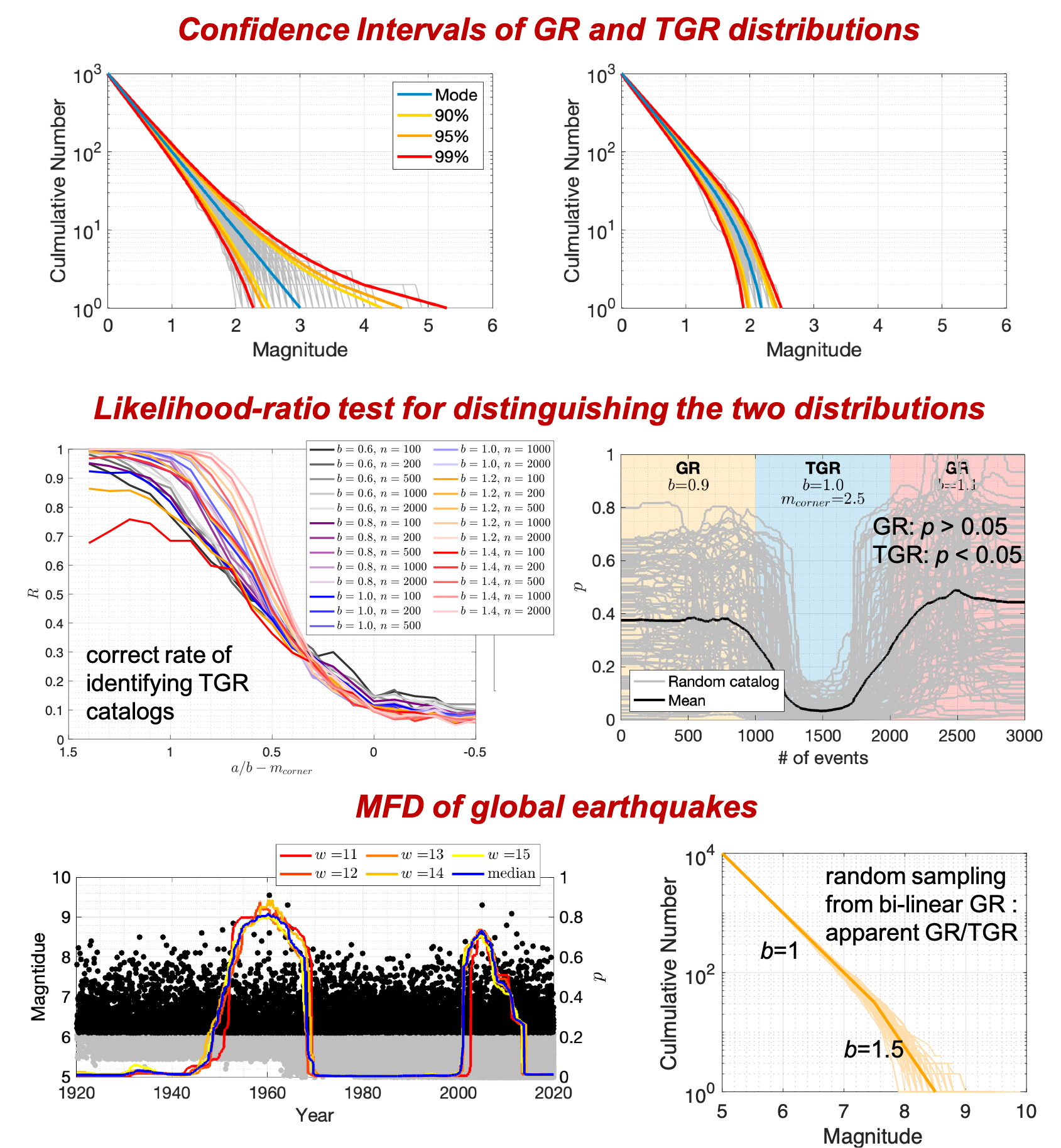Research

 |
Distinguishing tapered and non-tapered Gutenberg-Richter distributions
Accurately characterizing the magnitude–frequency distribution (MFD) of earthquakes is vital for advancing our understanding of
earthquake physics and improving seismic hazard assessments. In this study, we address key issues in distinguishing between the
classic Gutenberg–Richter distribution and its prominent alternative, the tapered Gutenberg–Richter distribution, which assumes a
reduced frequency of larger earthquakes. We find the most effective approach, identify the conditions under which these two
distributions can be distinguished, and propose an objective and automatic method to describe the temporal evolution of MFD.
Based on these insights, we revisit several earthquake sequences and demonstrate the practical applicability of both distributions,
highlighting their relevance in natural and induced seismicity contexts.
|
| Origin depth of the temporal variations in seismic speeds
Seismic interferometry is widely used to detect changes in the subsurface. In many previous studies, changes in Rayleigh-wave
velocity were interpreted as changes in shear wave velocity at specific depths, based on computed frequency-dependent sensitivity
kernels (low frequencies are related to deep depth). An important prerequisite for this assumption is that the S-wave
velocity changes at different depths are close. In this study, we use evidence from laboratory experiments, field
measurements, and seismic surface wave and coda wave results to show that, under the same
stress perturbation, the wave speed changes in shallow rocks are much greater than those in deep rocks.
On this basis, we suggest that changes in low-frequency Rayleigh-wave velocities may originate from the very
shallow crust (80% of the velocity changes may originate from the top 1 km),
calling for a reevaluation of the explanation for wave speed changes.
|
 |
 |
Feasibility of obtaining b-values for real-time earthquake catalogs
People tried to use Gutenberg–Richter b-values for short-term earthquake forecasts, and this requires the premise
of estimating reliable b-values for real-time seismic catalogs. In this study, through a series of numerical tests,
we investigate the performance of three methods, including the commonly used maximum likelihood estimation method
and two relatively new b-value estimation methods, namely the b-positive and K−M slope
methods, on calculating b-values for real-time seismic catalogs. We also apply these three methods to both observed
seismic catalogs and synthetic real-time seismic catalogs. We suggest it seems difficult to obtain accurate b-values
for real-time earthquake catalogs, but the combination of these methods may give a better judgment—if all three methods
suggest that the change in b-value is significant, the probability of making a wrong decision is very low.
|
| Use K–M slope (KMS) to study seismic sequences
The b-value from the Gutenberg–Richter law is an essential parameter in seismological studies.
However, its estimation faces many uncertainties. We generate synthetic seismic catalogs
that obey various probability distributions and find that 1) the KMS from Visibility
Graph Analysis is universally proportional to the b-value once the catalog size is given; 2) the KMS estimation can
perform better than b-value estimation for many catalogs. We apply the KMS
estimation to the real observed seismic catalog and find general consistency with
traditional b-value estimation methods. We suggest that the KMS can be used as a verification of or a supplement to b-value.
|
 |
 |
Seismicity in the Three Gorges Reservoir (TGR) area
The TGR area is located in the stable Yangtze paraplatform.
Because of human regulation, the reservoir water level and natural rainfall, which are suggested
to modulate seismicity, show opposite seasonal patterns.
We find the regional seismicity can be divided into two groups according to the distances to the reservoir.
Their productivity is proportional to the reservoir water level and precipitation, respectively.
The elastic response of reservoir water level rise can trigger most earthquakes near the reservoir.
The rainfall-induced pore pressure, a widely discussed mechanism, cannot explain the earthquakes far from the reservoir.
The combination of natrual-hydrosphere-induced elastic load and pore pressure may cause a signal consistent with rainfall
and may explain these earthquakes.
|
I appreciate the help and support from my advisors and collaborators: Jean-Philippe Avouac (California Institute of Technology), Nadia Lapusta (California Institute of Technology), Gang Luo (Wuhan University), Jiangtao Li (Wuhan University), Mian Liu (University of Missouri, now at SUSTech), Xiaodong Song (Peking University), and Kyungjae Im (California Institute of Technology).